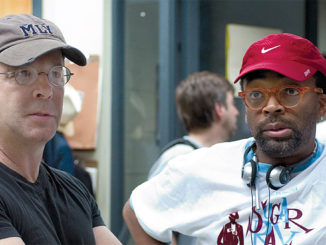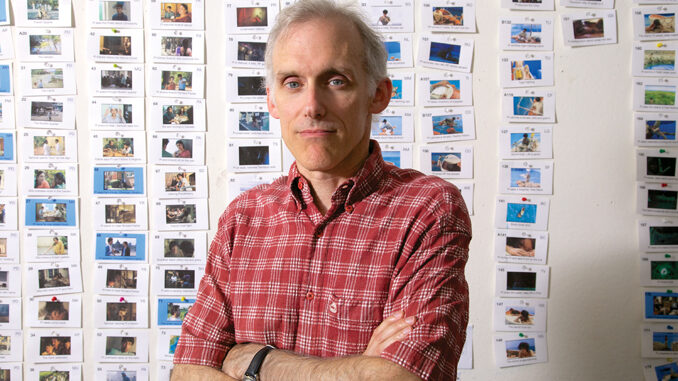
by Rob Feld • portraits by Deverill Weekes
The charmed career of Tim Squyres, A.C.E., has evidenced one of the most enduring editor-director partnerships. Beginning with director Ang Lee’s first feature film, Pushing Hands in 1992, Squyres has collaborated with Lee on the vast majority of his films since, up to and including the new Life of Pi (2012), a three-dimensional, technologically advanced fantasy about a shipwrecked teenager stranded on a lifeboat with a Bengal tiger. An early cut of the film opened the 2012 New York Film Festival in late September, preceding a national release November 21 through 20th Century Fox.
Even when he wasn’t working with Lee, Squyres has cut for the likes of Robert Altman, Jonathan Demme, Paul Auster and Alex Gibney, moving among narrative features, documentaries and some television. It all began in college, when Squyres got hooked by a class in film. He wound up as a teaching assistant for film classes and found work at the local TV station, doing every job he could find. When he moved to New York, one of Squyres’ ex-students was doing a film in NYU’s graduate program. Soon, he was doing sound and other jobs on student films, but gravitated towards editing. “I discovered that it’s one of the very few jobs in film where you’re involved in the whole story — not just doing your piece and handing it off,” Squyres recalls. “I liked that.”
He assisted editor John Tintori on films like Eight Men Out in 1988 and Dogfight in 1991, which led to his first editing gig, when the location manager from Eight Men Out started producing and needed an editor who would work on 1991’s Blowback for next to nothing. Squyres took the job, where he met the film’s first assistant director Ted Hope, who went on to found Good Machine with James Schamus, and to produce films for Lee. Someone was also needed to work inexpensively on Pushing Hands — but whatever the editor gave to that movie came back to him in spades.
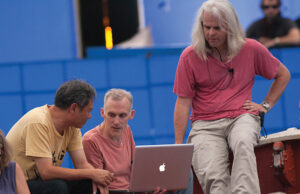
While in the final throes of post- production on Life of Pi, Squyres took time out to speak to CineMontage about the film, its special challenges and his career.
CineMontage: You’ve been working with Ang Lee for so long now;
10 feature films plus more. How has your working relationship developed over time?
Tim Squyres: Ang had never worked with an editor before Pushing Hands, so the process was new for him. His English was decent but nothing like a native speaker, and he didn’t know how to talk to an editor. We would often have long, roundabout discussions about whether we should trim something or not, and at the end I would say, “So, what about those 13 frames?” Sometimes I would just make cuts and let him react. Our tastes and interests are quite similar, so initially what we really had to do was learn how to communicate.
With all directors, you figure out what they need and what you have to do to support them, then try to make a comfortable working relationship where you can both explore everything you want. For us, because the communication was a little bit difficult, using the Avid on our second film [The Wedding Banquet] was great. If I wanted to try something, I could do it quickly and non-destructively, and show it to him. If you’re cutting on film, and the director wants to try a big idea that you thought wasn’t a good one — or not likely to be successful — you knew you would have to take it apart and eventually put it back together. At the time, those kinds of discussions were not necessarily what we were good at, so it was great to be able to make a cut and not worry about whether it was going to work. That way, it felt like we were exploring everything together.
CM: Has Lee come to shoot towards an edit?
TS: He doesn’t tend to shoot toward any specific cut, and he never gives me notes on how to edit the scene. Life of Pi is the first film he shot toward something specific — and that was required by the difficulty of shooting it. The film is so heavy in visual effects; it’s 3D, shot on water in a wave tank. You can’t just go in and figure it out on the day, so it was pre-visualized. To some extent, Ang and I worked a lot on that together. Some scenes were shot exactly as the previz, and others departed quite a bit. [See sidebar, page 30, in which Squyres discusses the challenges of editing Life of Pi.]
The only other time he storyboarded was on Hulk [2003], and those were largely ignored. For Life of Pi, I did a full sound edit on the previz so you could kind of watch it like a movie, which we used to get the film green-lit.
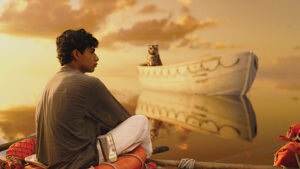
CM: The Ice Storm, Sense and Sensibility, Crouching Tiger, Hidden Dragon; these films all have different aesthetics. How were you two communicating before shooting by the time these films rolled around?
TS: The level to which I’m involved before shooting has changed over time. We always talk about how he’s planning on shooting it — what I think he should be looking for, stylistic considerations, etc. — and I give a lot of notes on the script. It’s a little bit different on each film. Something like Crouching Tiger, where I was reading virtually incomprehensible English translations of the Chinese script, there was very little I could say about the story.
CM: What do you find an editor needs from an actor?
TS: The big thing is for them to do something. Every cut should look like you’re leaving one shot and going to another for some purpose. Sometimes the reason for the cut is an actor blowing a line and I’m forced to cut, but to an audience, it should look like I’m leaving this person in the middle of speaking and going to this other person’s reaction to gain something. If actors stay engaged in the scene, they will often give you things.
When you have to get out of a shot, you go looking for reactions. Very often, the piece you use is the piece where the actor either breaks or regains eye contact with the person who’s speaking. If you’re in a scene where somebody else has a long speech, just once in a while look away and look back, please. It gives the editor something that looks like you’re listening. It can give more insight and focus attention on what the person is saying.
CM: Can you contrast some working styles between the myriad directors you’ve worked with? Editing an Altman film like Gosford Park must have been colossally different.
TS: Just managing the mayhem was a big part of that job, though I actually had less footage on that film than on any feature before, except for Pushing Hands. The cameras are moving in every shot of Gosford Park. Sometimes the movement is motivated and sometimes it isn’t. For a big dinner scene, we go to wide shot; two cameras would dolly back and forth and shoot three takes. Then you’d move closer and do it again. You’d flip around to the other side of the table, do it again and you’re done. And that’s what they’d give me.
Bob was not shooting normal coverage. Very often, I didn’t have anything like matching angles for normal reverses. Every scene was a house of cards, so I would do multiple versions to see what was there. It was really interesting. It’s the only way Bob could have shot a big, complicated film like that with the schedule he had.
TS: I had my own process for organizing footage, but it didn’t really work on that film. I had to come up with a new one by pulling line readings from each take that didn’t work. In this case, I would watch the footage, find the pieces that I really liked, and try and figure out a way to use as many of them as I could in the same cut. For a while, I thought I was losing my mind.
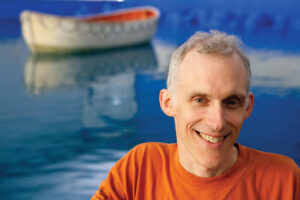 I had seen a lot of Altman films, but once you’re inside that aesthetic, it takes a while to figure it out. Once I did, though, it went quickly. I don’t think I ever saw Bob for more than three or four hours a day, whereas Ang is usually sitting next to me all day. I would have my cut and be happy with it, then Bob would come in and hit it with a stick, leave and let me pick up the pieces. Sometimes that would lead to very interesting things.
I had seen a lot of Altman films, but once you’re inside that aesthetic, it takes a while to figure it out. Once I did, though, it went quickly. I don’t think I ever saw Bob for more than three or four hours a day, whereas Ang is usually sitting next to me all day. I would have my cut and be happy with it, then Bob would come in and hit it with a stick, leave and let me pick up the pieces. Sometimes that would lead to very interesting things.
CM: Did the process of assembling that sort of footage, and maybe even that of director Jonathan Demme’s, have more kinship with the documentary editing you also do?
TS: Very much so. It’s good that I did Gosford Park before Demme’s Rachel Getting Married because the new organizational style I developed was very much what I had to do for Rachel — which was Gosford Park on steroids. The coverage was so completely non-traditional. If the rehearsal dinner was 45 minutes, there were 45-minute takes with 5 cameras. The actors would play the whole scene. I would cut it like a documentary of an event, keeping in mind that certain dramatic things were important. So the documentary experience I had was very important. The good thing about shooting a scene in that way is that the actors are never waiting for their close-ups. They just play the scene.
CM: Ride with the Devil was the first action-oriented film you and Lee did. What did you learn about servicing the needs of both character and action, or is there no difference?
TS: Action scenes should be character and emotion scenes, only people are doing things quickly or dangerously. You should never say, “Now we’re doing action so we can stop our character development.” The exciting thing about a chase is either the fear felt by the person being chased, or whatever the need is of the person who’s doing the chasing. Those things are very important. You have to get a feel for the action playing well by itself, but you can never lose track of the characters.
In Crouching Tiger, most of the fight scenes were pretty tightly choreographed, so it was a matter of looking for character moments to balance with all the handwork; what’s important was the look on the actor’s face before she turns. Why I’ll pick take 17 instead of 93 of something is because of a nanosecond where something happened between kicks. We were going for a fluid feel in those fight scenes. You balance keeping the energy flow correct through an action scene with keeping track of your actors, your story and remembering why these people are fighting or chasing each other.
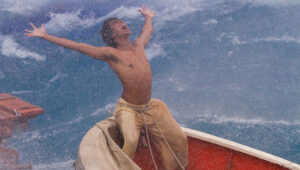
CM: When you started out, you were cutting film; there was more of a tactile interaction with film stock as opposed to digital editing. How has that changed your process over the years?
TS: I assisted on four features and then cut one film. I had also done a lot of editing on tape, on TV stuff before that. Then I cut Ang’s second film on Avid, The Wedding Banquet. That was very, very early in the process. The decision to use an Avid was driven by money. Nobody really knew what the thing was, but our producer said, “If we do this, we don’t need a work print. This thing will save money.” So, the first film I ever saw was an answer print. I also cut all the music and production tracks in the Avid. We took the Avid to Sound One in New York and laid off the tracks two at a time to an analogue 16-track recorder, and that’s what we mixed from. The only thing that we edited outside of the Avid was sound effects.
CM: So you learned on the job?
TS: There was nobody to learn from at the time! You would recognize the interface now, but it came on five floppy disks. People only used it then for commercials and music videos — and the image quality was terrible.
Yes, there is something to be said for the tactile nature of film, but I found that what’s important for me is understanding the picture and sound — being mentally in the movie. Going over to the rack and getting film, handling film — those are distractions from keeping your mind submerged in the movie. I very quickly got over the need for handling the film. At the time, you could make the argument that the image suffered badly when cutting digitally, but obviously that argument is moot now. On Life of Pi, we were cutting DNx 115 3D film, and my editing monitor was a 3D Christie projector showing an image half the resolution of the finished film in a theatre — which is way better than you’re ever going to see on a Steenbeck.
But in terms of actual film handling, I was not that nostalgic. I had been an assistant for a long time and it had been years since I cut myself on a splicer; when you do it all day, every day, it becomes second nature and you stop cutting yourself. Then I did my first Avid job and went back and did a film job — and on the first day I cut myself. I haven’t cut on film since 1994.




